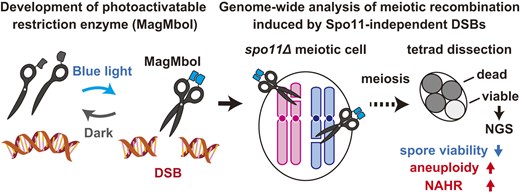2025-04-11 東京大学,科学技術振興機構
<関連情報>
- https://www.c.u-tokyo.ac.jp/info/news/topics/20250411090100.html
- https://academic.oup.com/nar/article/53/7/gkaf206/8109934?login=false
MagTAQによる光制御Spo11レス減数分裂DNA切断が染色体異常を引き起こす Light-controlled Spo11-less meiotic DNA breaks by MagTAQing lead to chromosomal aberrations
Hideyuki Yone, Yuri Kawashima, Hayato Hirai, Arisa H Oda, Moritoshi Sato, Hiromitsu Kono, Kunihiro Ohta
Nucleic Acids Research Published:10 April 2025
DOI:https://doi.org/10.1093/nar/gkaf206

Graphical Abstract
Abstract
TAQing technologies are based on the restriction enzyme-induced DNA double-strand break (DSB) formation in living cells, which results in large-scale genomic rearrangements and phenotypic alterations. Originally, the TAQing system requires heat treatments to activate restriction enzymes, which sometimes leads to cell toxicity or stress responses. Here, we developed a blue-light-controlled MagTAQing system, which induces DSBs exclusively upon blue-light exposure by assembling the split restriction enzymes via Magnet modules. Application of MagTAQing to mitotic budding yeast cells successfully triggered various genomic rearrangements upon blue-light exposure. Since this technology enables the conditional induction of genomic rearrangements in specific cells or tissues, we employed MagTAQing on meiotic yeast cells lacking the recombinase Spo11 to induce artificial DSBs. Consequently, Spo11-independent meiotic DSBs resulted in aneuploidies and nonallelic homologous recombinations between repetitive sequences such as ribosomal DNA and retrotransposons. These results suggest a pivotal role of Spo11-induced recombination in preventing chromosomal abnormality.


